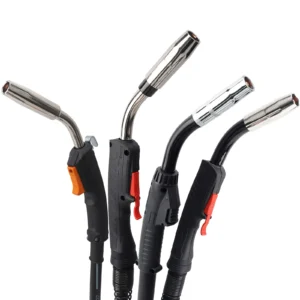Table of Contents
ToggleROBOTIC MIG WELDING TORCH
When it comes to automated welding processes, a robotic MIG welding torch plays a crucial role. With its precise control and efficiency, it offers numerous benefits for industrial applications. In this article, we will explore the key factors to consider when choosing and optimizing a robotic MIG welding torch, highlighting its benefits and application areas. By understanding these aspects, customers can make informed decisions and maximize the potential of their welding operations.
1. Understanding the Key Components:
Before delving into the crucial factors for choosing a robotic MIG welding torch, it’s essential to understand its core components. The torch consists of a nozzle, contact tip, diffuser, and retaining head. Each component contributes to the overall performance and weld quality. For instance, the nozzle directs the shielding gas, ensuring proper protection for the weld pool. The contact tip conducts the welding current, while the diffuser evenly distributes the shielding gas flow. The retaining head secures and aligns these components, ensuring stability during welding.
2. Consideration Factors for Choosing a Robotic MIG Welding Torch:
a) Durability and Build Quality: When selecting a welding torch, it is imperative to evaluate its durability and build quality. As robotic welding processes involve continuous use, the torch must withstand the demanding conditions of industrial operations. Opting for a torch with high-quality materials and construction ensures longevity and reduces the need for frequent replacements.
b) Torch Size and Weight: The size and weight of the robotic MIG welding torch are crucial considerations, as they impact the agility and flexibility of the robot arm. A compact and lightweight torch allows for more precise movements and can access tight spaces, enhancing overall welding efficiency.
c) Cooling Mechanism: Robotic MIG welding torches generate heat during prolonged use, which may affect performance and cause damage. Therefore, it is crucial to choose a torch with an efficient cooling mechanism, such as an integrated water cooling system. This ensures consistent operation and minimizes the risk of overheating, allowing for longer welding durations.
d) Torch Configurations: Different welding applications require specific torch configurations. For instance, a torch with a swan neck design allows better access to complex joint geometries, while a curved neck torch improves reachability in certain welding positions. By understanding the unique requirements of the intended welding task, customers can choose the appropriate torch configuration for optimal results.
3. Benefits and Application Areas:
a) Enhanced Productivity: The utilization of a robotic MIG welding torch significantly enhances productivity by automating the welding process. With precise and consistent welds, it eliminates human error and reduces the need for rework. This benefit enables industries to meet higher production demands efficiently and effectively.
b) Improved Weld Quality: The automated nature of robotic welding, combined with the accuracy of a MIG torch, ensures superior weld quality. The torch’s precise control over arc length, wire feed rate, and shielding gas flow guarantees uniform penetration, minimized spatter, and impeccable bead appearance. These qualities are crucial for industries that demand top-notch welds, such as automotive, aerospace, and fabrication sectors.
c) Time and Cost Savings: By streamlining the welding process and minimizing errors, a robotic MIG welding torch saves valuable time and reduces labor costs. Since the torch operates continuously, it eliminates downtime associated with labor changeovers. Additionally, its efficiency reduces material waste and rework expenses, contributing to overall cost savings.
d) Versatility and Adaptability: Robotic MIG welding torches are highly versatile, capable of handling various materials, thicknesses, and joint types. Whether it’s carbon steel, stainless steel, or aluminum, the torch can adapt to the specific welding requirements. This versatility makes it a valuable asset in diverse industries, including automotive, construction, and metal fabrication.
4. Optimizing Performance:
Apart from choosing the right robotic MIG welding torch, optimizing its performance is equally vital. Regular maintenance and cleaning of the torch components ensure proper functionality and extend its lifespan. The proper alignment of the torch to the robot arm, along with optimizing welding parameters, further enhances the welding process. Additionally, integrating advanced welding technologies, such as real-time monitoring and adaptive control, can maximize weld quality and productivity.
In conclusion, selecting and optimizing a robotic MIG welding torch requires a thorough understanding of its key components, consideration factors, benefits, and application areas. By focusing on durability, size, cooling mechanism, and torch configurations, customers can choose a torch that meets their specific needs. The benefits of enhanced productivity, improved weld quality, time and cost savings, along with the versatility of the torch, make it an invaluable tool in various industries. Finally, optimizing performance through maintenance, alignment, and adopting advanced technologies ensures consistent and efficient welding operations. With this knowledge, customers can make informed decisions and unlock the full potential of their automated welding processes.

